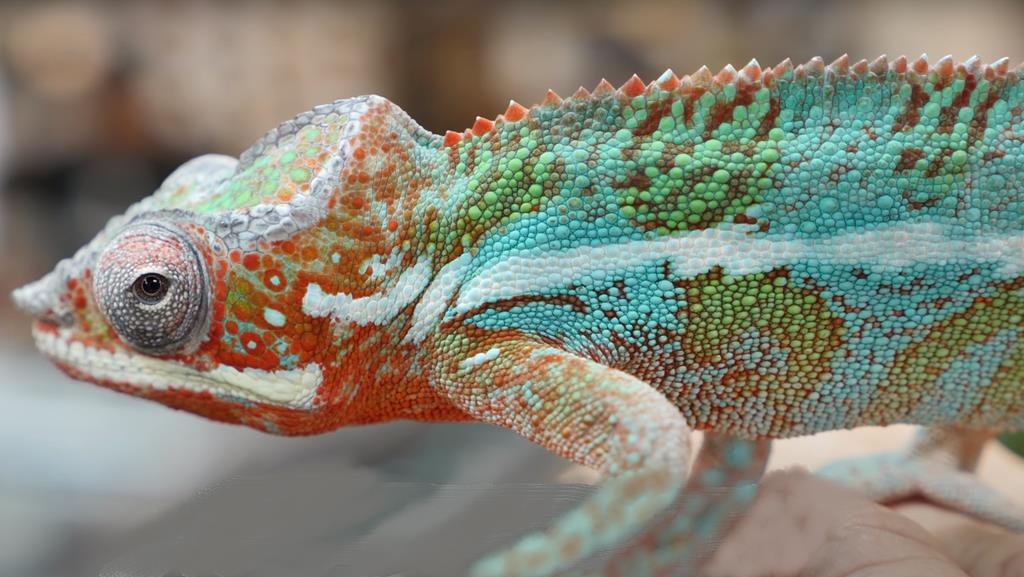To give a chameleon fluids, use a dropper or syringe to gently drip water onto its snout. Ensure the chameleon voluntarily licks the water to avoid aspiration.
Chameleons require proper hydration, but they don’t drink from a water bowl like other pets. Instead, they lap up droplets from leaves in their natural habitat. Captive chameleons often need assistance with hydration, especially during illness or if they refuse to drink on their own.
Pet owners can mimic natural conditions by providing a slow drip of water that the chameleon can notice and drink at its own pace. It’s essential to offer fluids in a stress-free manner, as chameleons are easily disturbed by unfamiliar routines or forceful actions. Keeping them well-hydrated contributes significantly to their overall health, helping to prevent common issues such as dehydration and aiding in the recovery from illness.
Signs Your Chameleon Needs Hydration
Chameleons, like other reptiles, may not always make it obvious when they need water. Understanding the signs that your chameleon needs hydration is crucial for their health and well-being. Let’s look at the physical symptoms and behavioral changes that can help you determine when it’s time to provide fluids.
Physical Symptoms Of Dehydration
Chameleons show several clear physical signs when dehydrated. Some symptoms to watch for include:
- Sunken eyes: A chameleon’s eyes might appear deflated or receded.
- Loss of skin elasticity: Gently pinch their skin; if it stays ridged, hydration is necessary.
- Dry, flaky skin: This indicates that they haven’t been getting enough water.
- Weight loss: Dehydrated chameleons often lose weight, so monitor their mass regularly.
Behavioral Changes Indicating Thirst
A chameleon’s behavior also changes with dehydration. These behaviors may include:
| Behavior | Description |
|---|---|
| Lethargy: | Lack of movement or interest in surroundings. |
| Appetite loss: | Reluctance or refusal to eat is often linked to a lack of fluids. |
| Gaping: | Chameleons might gape when they are excessively thirsty. |
| Color change: | Changing colors more often can be a call for help. |
If you notice any of these signs, it is time to give your chameleon fluids. Prompt action can prevent more serious issues and keep your chameleon healthy.
Safe Handling Of Chameleons For Treatment
When your chameleon falls ill and requires fluids, safe handling is essential. These delicate creatures can become stressed easily. Knowing the right approach and restraint technique helps ensure your pet’s well-being. Let’s look at how to approach and restrain your pet chameleon without causing it stress.
Approaching Your Pet
Moving with care is key when approaching your chameleon. Sudden movements may frighten it. Begin by speaking softly to signal your presence. Always move at eye level to avoid intimidating your pet. Patient and gentle handling builds trust for successful treatment.
Restraining Techniques Without Stress
- Wait for your chameleon to climb onto you; forceful handling is a no-go.
- Offer a stick or extended finger for it to grasp.
- Gently cup your hand around it without squeezing.
- Support its feet to make your chameleon feel secure.
Never grab by the tail or limbs, as this can cause injury. With these tips, you can give your chameleon fluids with minimal stress.
Preparing Fluids For Your Chameleon
Chameleons, with their stunning colors and unique behaviors, are captivating pets. Like all living creatures, they need proper hydration to stay healthy. Knowing how to prepare fluids for your chameleon is vital. This guide simplifies the process, ensuring your pet receives the care it deserves.
Choosing The Right Type Of Fluid
Selecting an appropriate fluid for your chameleon is crucial. Use clean water or veterinarian-recommended electrolyte solutions. These are best for keeping your chameleon hydrated. Tap water can contain chlorine, so it’s safer to use filtered or bottled water.
- Dechlorinated water – Let tap water sit for 24 hours before use.
- Electrolyte solutions – Seek vet advice for proper products.
- Hydration supplements – Also vet-endorsed, can aid chameleon health.
Temperature And Quantity
The temperature of the prepared fluids impacts your chameleon’s willingness to drink. Ensure fluids are at room temperature, mimicking their natural environment. Avoid cold fluids, as they can shock your pet’s system.
When it comes to quantity, moderation is key. Too much fluid may overwhelm your chameleon, while too little won’t be enough to hydrate. A general guideline is to offer 2-5 ml of fluid every time, depending on the size of your chameleon.
| Size of Chameleon | Fluid Quantity | Frequency |
|---|---|---|
| Small | 2 ml | Daily |
| Medium | 3-4 ml | Daily |
| Large | 4-5 ml | Daily |
Administering Fluids Correctly
Keeping your chameleon hydrated is critical for its health. Sometimes, chameleons require extra help from their caretakers for proper fluid intake. There are several methods to ensure your chameleon gets the fluids it needs. From oral hydration techniques to soaking practices and subcutaneous injection methods, all require careful attention to detail. Remember to consult with a vet when in doubt, especially regarding injections.
Oral Hydration Methods
Generating effective oral hydration for your chameleon involves precision. Use a syringe or dropper to carefully release water near their mouth. They might lick the droplets. Never force their mouth open. This method helps maintain adequate moisture levels inside their body.
Soaking Practices
Introducing gentle soaking practices can aid in your chameleon’s hydration. Fill a shallow dish with warm water and allow your chameleon to wade. Keep the sessions short, making sure the water is not too deep. Monitoring during this process is essential to prevent any stress or drowning risks.
Subcutaneous Injection Techniques
- Consult with a vet: Learn the correct process from a professional.
- Gather the supplies: Sterile needles, saline solution, and disinfectant.
- Prepare the chameleon: Hold gently; ensure they’re calm.
- Locate injection site: Look for the area advised by the vet.
- Disinfect the area: Use an alcohol wipe to clean it.
- Administer the fluid: Inject slowly as instructed by the vet.
- Monitor post-injection: Check for any adverse reactions.
This technique delivers hydration directly into the body and is usually reserved for critical situations.
Monitoring And Aftercare
Providing fluids to a chameleon is essential for its recovery and health. Proper monitoring and aftercare are just as crucial to ensure your colorful friend bounces back with vibrancy. After administering fluids, careful observation and a commitment to ongoing hydration will pave the way for a smoother recovery. Let’s delve into how we can keep a watchful eye on our chameleon post-treatment and maintain their hydration levels.
Observing Your Chameleon Post-treatment
Post-treatment care for your chameleon starts with keen observation. Watch for these signs of improvement:
- Active Eyes: They should be moving and alert.
- Eating Habits: Look for a return of appetite.
- Skin Color: Bright, normal colors are a good sign.
- Movement: Your chameleon should start moving more.
Record these behaviors daily:
Add more rows as needed| Date | Behavior | Notes |
|---|---|---|
| 04/01 | Active Eyes | Better than yesterday |
Consult a vet if improvement stalls or your pet’s condition worsens.
Ensuring Ongoing Hydration
Hydration is key for your chameleon’s recovery. Ensure it gets enough water:
- Misting: Mist the habitat twice daily.
- Water Drips: Set up a drip system for drinking.
- Humidity: Keep humidity levels consistent.
- Hydration Supplements: Use recommended supplements.
Check the water supply every day and clean the water features regularly to prevent bacteria growth. Remember, a well-hydrated chameleon is a happy chameleon!
Preventing Dehydration In Chameleons
Chameleons, with their vibrant colors and mesmerizing eyes, are fascinating pets. Essential to their care is preventing dehydration, a common issue that can lead to health problems. Ensuring your chameleon stays hydrated involves several key practices and a little know-how to maintain their well-being. Let’s explore the steps to keep your scaly friend healthy and hydrated.
Creating Optimal Living Conditions
Proper habitat conditions are crucial for a chameleon’s hydration. Since they absorb water through their skin and drink droplets from leaves, their enclosure must replicate their natural environment.
- Humidity: Maintain a humidity level between 50-70%.
- Watering system: Use misters or drippers for consistent moisture.
- Clean water: Always provide access to fresh, clean water.
- Plants: Include live plants that can hold water on their leaves.
Adjust these settings to meet your pet’s needs and monitor them regularly with a hygrometer.
Regular Health Check-ups
Chameleons are experts at hiding illness. Regular vet visits can catch early signs of dehydration. Look out for signs such as sunken eyes, lethargy, and dry skin. A veterinarian can recommend fluid supplements or adjustments in their care routine. Keep a consistent check-up schedule to ensure your chameleon’s health.
Educating Yourself On Species-specific Needs
Different chameleon species have unique requirements. Understanding the specific needs of your chameleon’s species is vital. Research their natural habitat, diet, and behavior. Join forums, read books, and consult with experts to gather the right information. Knowledge empowers you to create an environment where your chameleon can thrive.
Frequently Asked Questions On How Do You Give A Chameleon Fluids?
How Do I Hydrate My Chameleon?
Ensure your chameleon stays hydrated by providing a drip system or misting their enclosure regularly. Offer fresh water in a shallow dish and maintain appropriate humidity levels.
How Do You Get A Chameleon To Drink?
To encourage a chameleon to drink, provide a drip system or mist the leaves in their habitat, as chameleons prefer to lap water from surfaces rather than drinking from bowls.
Will A Chameleon Drink Water From A Bowl?
Chameleons usually do not drink from a bowl. They prefer to lick water droplets off leaves, mimicking their natural rainforest habitat for hydration.
How Do You Give A Chameleon Water With A Syringe?
To give a chameleon water with a syringe, gently place the syringe tip near the chameleon’s mouth and slowly release drops. Ensure the water is room temperature and observe as the chameleon licks the droplets. Avoid forcing water or stressing the reptile during hydration.
Conclusion
Ensuring your chameleon stays hydrated is crucial for its health and vitality. By following the steps outlined, you can safely administer fluids and help your pet thrive. Remember, patience and gentle handling are key. Keep a close watch for signs of dehydration and provide a loving, attentive environment for your colorful companion.
Stay informed, and your chameleon will thank you with its vibrant presence.


